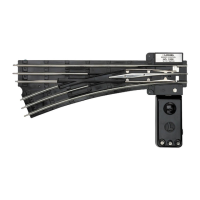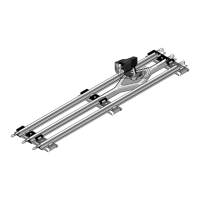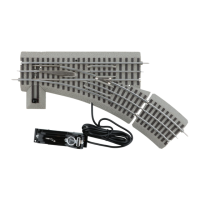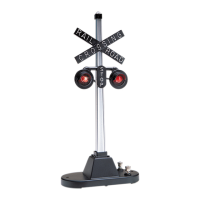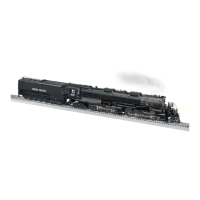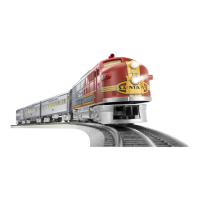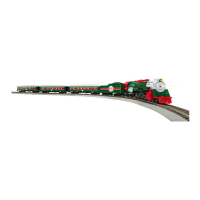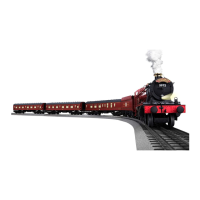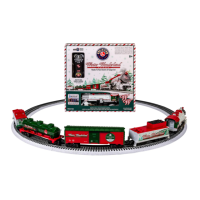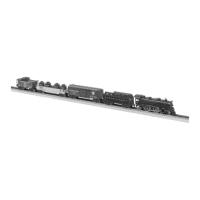Do you have a question about the Lionel O and is the answer not in the manual?
Always use a transformer to connect your Lionel train layout to household electric outlets for safe operation.
Verify your transformer's voltage and cycle rating matches your home's electrical supply to prevent damage.
Transformers cannot be used with DC current; special control units are needed for DC power sources.
Lionel transformers are UL approved. Circuit breakers are recommended for specific transformer models.
Provides initial directions for setting up and running your first Lionel train outfit.
Covers voltage requirements, transformer capacity, and wiring for accessories.
Guidance on selecting space, designing track, constructing framework, and landscaping.
Information on finding and eliminating trouble spots for optimal performance.
Inspect all components for damage, ensure wheels turn freely, and lubricate as needed.
Instructions for assembling basic track layouts directly on the floor.
Details on Lionel's 'O', '027', and 'Super-0' track types and assembly.
Information on specific track components like uncoupling units and lockons.
Step-by-step guide for connecting track lockons to the transformer.
Illustrates connections for various Lionel transformer models to '0' and '027' track.
Details on assembling 'Super-O' track sections, including power bus bars.
Description of 'Super-0' track lockons and their wiring connections.
Explains how to connect power and control blades for 'Super-0' track operation.
Guidance on properly placing locomotives and cars on the track for operation.
Explains short circuits, their causes, and transformer protection features.
Identifies common trouble spots like derailed wheels, debris, and wiring faults.
How to control train speed using the transformer's voltage control.
Explanation of the locomotive's E-Unit and how to reverse direction.
Procedure for disabling the E-Unit's reversing function.
How to operate the whistle and horn using the transformer's controls.
Details on Lionel's 'Magne-Traction' feature for improved pulling power.
Proper use of smoke pellets and fluid, and safety precautions.
Tips for keeping the smoke generator functioning correctly.
Explanation of Lionel's remote control couplers and their operation.
Overview of operating cars powered by contact slide shoes on the track.
Details on the operation of the 'low-bridge' signal and giraffe car.
Explanation of the lumber car's dumping mechanism and activation.
Instructions for using the track cleaning and drying car.
Operation of the twin-bin dump car and its trackside activation.
Summary of operating voltages needed for various Lionel accessories.
Details on powered accessories like lamps, signals, and stations.
Information on accessories that interact with track or require specific connections.
Guidance on wiring multiple accessories to the same transformer posts.
How to use pressure-type and electrical contactors for signal automation.
Using insulated rails to trigger signals and accessories automatically.
How to wire switches to operate using insulated track sections.
Connecting accessories like crossing gates and signals using contactors or rails.
Wiring instructions for the No. 145 Gateman accessory.
Wiring instructions for the No. 151 Semaphore accessory.
Wiring instructions for the No. 353 Control Signal accessory.
Installation and operation guide for the No. 154 Crossing Signal.
Interlocking Dwarf Signals with track blocks and controllers.
Usage and wiring of the No. 350 Transfer Table for engine yards.
Instructions for operating the No. 264 Forklift Platform.
Details on installing and operating the No. 464 Lumber Mill.
Operation and connection of the animated newsstand accessory.
Operation and wiring for the No. 334 Dispatching Board.
Installation of No. 1122 switches for '027' track and controller connections.
Details on 'Super-0' track switches, including electrical and safety features.
Step-by-step guide for installing and wiring No. 022 switches.
Using manual switches for sidings, yards, and branch lines.
Applications of non-derailing mechanisms for automatic train routing.
Interlocking signals with switches for automatic operation.
Using track crossings to create complex layouts without switches.
Overview of 'O', '027', and 'Super-0' track gauges, curves, and dimensions.
Techniques for securely mounting track to a layout board or platform.
Description of Lionel's special pliers for track pin and wire manipulation.
Using insulated track sections for automatic accessory operation.
Methods for intermixing 'O', '027', and 'Super-0' track types.
Using adapter pieces to connect 'Super-0' track to '0' track.
Using adapter pieces to connect 'Super-0' track to '027' track.
Using insulated blocks in a single loop to control train spacing.
Diagram showing block wiring for automatic train control.
Method to retain locomotive reversing function when using insulated blocks.
Arranging multiple insulated loops for independent train control.
Example 'O' layout with sidings, showing control through lockons.
How a block system with relays and signals prevents collisions.
Using circuit breakers to protect relays from heavy short-circuit current.
Using the No. 110 Trestle Set to create graduated mountain sections.
Illustrations of various layouts incorporating the trestle set.
Steps for planning a model railroad layout, including sketching and space assessment.
Description of 'Super-0' layout types and required track components.
Guidance on building table or shelving layouts for optimal viewing and access.
Examples of layouts designed for two 4'x8' plywood sheets.
Techniques for creating gradual grades using trestles for realistic mountain sections.
Tips on adding realism through landscaping, mountains, and natural features.
How to clean electrical contacts, track, wheels, and car bodies.
Proper lubrication of locomotives and cars to ensure smooth operation.
Parts of Lionel equipment that should not be lubricated to avoid interference.
Identifying specific points on locomotives and cars that require lubrication.
Detailed steps for cleaning locomotive motors, commutators, and brushes.
Diagnosing and resolving common motor issues like sluggishness or non-operation.
Comprehensive wiring diagram for the 4'x8' Super 'O' track layout.
Comprehensive wiring diagram for the 5'x9' Super 'O' track layout.
Comprehensive wiring diagram for the 4'x8' '027' track layout.
